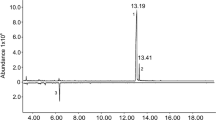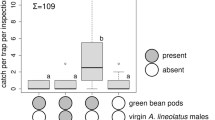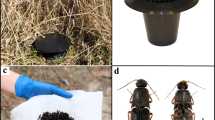Abstract
The Asian eulophid wasp Tetrastichus planipennisi is being released in North America as a biocontrol agent for the emerald ash borer (Agrilus planipennis), a very destructive invasive buprestid beetle that is devastating ash trees (Fraxinus spp.). We identified, synthesized, and tested a female-produced sex pheromone for the wasp. The key component eliciting behavioral responses from male wasps in flight tunnel bioassays was identified as (6S,10S)-(2E,4E,8E)-4,6,8,10-tetramethyltrideca-2,4,8-triene. Female specificity was demonstrated by gas chromatographic (GC) comparison of male and female volatile emissions and whole body extracts. The identification was aided by coupled gas chromatography/mass spectrometry analysis, microchemical reactions, NMR, GC analyses with a chiral stationary phase column, and matching GC retention times and mass spectra with those of synthetic standards. The tetramethyl-triene hydrocarbon was synthesized as a mixture of two enantiomeric pairs of diastereomers, and as the pure insect-produced stereoisomer. In flight-tunnel bioassays, males responded to both the natural pheromone and the chiral synthetic material by upwind flight and landing on the source. In contrast, the mixture of four stereoisomers was not attractive, indicating that one or more of the “unnatural” stereoisomers antagonized attraction. Field trials, using yellow pan traps baited with natural pheromone, captured significantly more male wasps than control traps over a four week trial. The identified pheromone could increase the efficiency and specificity of the current detection methods for Tetrastichus planipennisi and aid in the determination of parasitoid establishment at release sites.







Similar content being viewed by others
References
Abell K, Poland T, Cossé A, Bauer L (2015) Trapping techniques for emerald ash borer and its introduced parasitoids, pp. 113–127, in Van Driesche RG, Reardon RC (eds.), Biology and Control of Emerald Ash Borer. U.S. Department of Agriculture, Forest Service, Forest Health Technology Enterprise Team, Morgantown, WV. FHTET-2014-09. Available at: https://www.nrs.fs.fed.us/pubs/49295
Ayasse M, Paxton RJ, Tengo J (2001) Mating behavior and chemical communication in the order Hymenoptera. Annu Rev Entomol 46:31–78
Bartelt RJ (1999) Sap Beetles. In: Hardie J, Minks AK (eds) Pheromones of non-lepidopteran insects associated with agricultural plants. CABI Publishing, New York, pp 69–89
Bartelt RJ, Dowd PF, Plattner PD, Weisleder D (1990) Aggregation pheromone of dried fruit beetle, Carpophilus hemipterus: wind-tunnel bioassay and identification of two novel tetraene hydrocarbons. J Chem Ecol 16:1015–1039
Bauer LS, Liu HP, Miller DL, Gould J (2008) Developing a biological control program for emerald ash borer (Agrilus planipennis), an invasive ash pest in North America. Newsl Michigan Entomol Soc 53:38–39
Bauer LS, Liu H, Miller D (2009) Emerald ash borer biological control: rearing, releasing, establishment, and efficacy of parasitoids, pp. 7–8, in McManus KA, Gottschalk KW (eds.). Proceedings. 20th U.S. Department of Agriculture interagency research forum on invasive species; 2009 January 13–16; Annapolis, MD. Gen. Tech. Rep. NRS-P-51. Newtown Square, PA: U.S. Department of Agriculture, Forest Service, Northern Research Station. Available at: https://www.nrs.fs.fed.us/pubs/34330
Bauer LS, Gould J, Duan J, Hansen J, Cossé A, Miller D, Abell K, Van Driesche R, Lelito J, Poland T (2012) Sampling methods for recovery of exotic emerald ash borer parasitoids after environmental release, pp. 2–5, in McManus KA, Gottschalk KW (eds.). Proceedings. 22nd U.S. Department of Agriculture interagency research forum on invasive species; 2011 January 10–13; Annapolis, MD. Gen. Tech. Rep. NRS-P-92. Newtown Square, PA: U.S. Department of Agriculture, Forest Service, Northern Research Station. Available at: http://nrs.fs.fed.us/pubs/39810
Bauer LS, Duan JJ, Gould J (2014) Emerald ash borer (Agrilus planipennis Fairmaire) (Coleoptera: Buprestidae), pp. 189–209, in Van Driesche R, Reardon R. (eds.). The Use of Classical Biological Control to Preserve Forests in North America. U.S. Department of Agriculture, Forest Service, Forest Health Technology Enterprise Team, Morgantown, WV. FHTET-2013-02. Available at: http://www.fs.fed.us/foresthealth/technology/pdfs/FHTET-2013-2.pdf
Bauer LS, Duan JJ, Gould JR, Van Driesche R (2015) Progress in the classical biological control of Agrilus planipennis Fairmaire (Coleoptera: Buprestidae) in North America. Can Entomol 147:300–317
Bauer L, Hansen J, Gould J (2016) Yellow Pan Traps: A Simple Method for Trapping Parasitoids Released for Biological Control of the Emerald Ash Borer. Available at: https://www.nrs.fs.fed.us/disturbance/invasive_species/eab/local-resources/downloads/YPT_Method20160304.pdf
Bray AM, Bauer LS, Poland TM, Haack RA, Cognato AI, Smith JJ (2011) Genetic analysis of emerald ash borer (Agrilus planipennis Fairmaire) populations in Asia and North America. Biol Invasions 13:2869–2887
Cooperband MF, Hartness A, Lelito JP, Cossé AA (2013) Landing surface color preferences of Spathius agrili (Hymenoptera: Braconidae), a parasitoid of emerald ash borer, Agrilus planipennis (Coleoptera: Buprestidae). J Insect Behav 26(5):721–729
Cossé AA, Petroski RJ, Zilkowski BW, Vermillion K, Lelito JP, Cooperband MF, Gould JR (2012) Male-produced pheromone of Spathius agrili, a parasitoid introduced for the biological control of the invasive emerald ash borer, Agrilus planipennis. J Chem Ecol 38(4):389–399
Duan JJ, Bauer LS, Abell KJ, Lelito JP, Van Driesche R (2013) Establishment and abundance of Tetrastichus planipennisi (Hymenoptera: Eulophidae) in Michigan: potential for success in classical biocontrol of the invasive emerald ash borer (Coleoptera: Buprestidae). J Econ Entomol 106:1145–1154
Duan JJ, Bauer LS, Van Driesche RG (2017) Emerald ash borer biocontrol in ash saplings: the potential for early stage recovery of north American ash trees. Forest Ecol Manag 394:64–72
Duan JJ, Bauer LS, Van Driesche RG, Gould JR (2018) Progress and challenges of protecting north American ash trees from the emerald ash borer using biological control. Forests 9:1–17
Duan JJ, Van Driesche RG, Crandall RS, Schmude JM, Rutledge CE, Slager BH, Gould JR, Elkinton JS (2019) Establishment and early impact of Spathius galinae (Hymenoptera: Braconidae) on emerald ash borer (Coleoptera: Buprestidae) in the northeastern United States. J Econ Entomol 112(5):2121–2130
El-Sayed AM, Godde J, Arn H (1999) Sprayer for quantitative application of odor stimuli. Environ Entomol 28:947–953
Emeraldashborer Info (2020) (http://emeraldashborer.info)
Evans DA, Ennis MD, Mathre DJ (1982) Asymmetric alkylation reactions of chiral imide enolates. A practical approach to the enantioselective synthesis of α-substituted carboxylic acid derivatives. J Am Chem Soc 104:1737–1739
Federal Register (2007) Availability of an environmental assessment for the proposed release of three parasitoids for the biological control of the emerald ash borer (Agrilus planipennis) in the continental United States. Fed Regist 72:28947–28948 (http://www.regulations.gov/#!docketDetail;D=APHIS-2007-0060)
Federal Register (2015) Availability of an environmental assessment for field release of the parasitoid Spathius galinae for the biological control of the emerald ash borer (Agrilus planipennis) in the contiguous United States. Fed. Regist. 2015, 80: 7827–7828. (https://www.regulations.gov/ docket?D=APHIS-2014-0094)
Geerdink D, Buter J, van Beek TA, Minnaard AJ (2014) Asymmetric total synthesis of a putative sex pheromone component from the parasitoid wasp Trichogramma turkestanica. Beilstein J Org Chem 10:761–766
Gould JR, Bauer LS, Duan JJ, Williams D, Liu H (2015) History of emerald ash borer biological control. pp. 83–95. In: Van Driesche RG, Reardon RC (eds.), Biology and Control of Emerald Ash Borer. U.S. Department of Agriculture, Forest Service, Forest Health Technology Enterprise Team, Morgantown, WV. FHTET-2014-09. Available at: https://www.nrs.fs.fed.us/pubs/49321
Haack RA, Jendek E, Liu H, Marchant KR, Petrice TR, Poland TM, Ye H (2002) The emerald ash borer: a new exotic pest in North America. Newsletter Michigan Entomol Soc 47:1–5 Available at: https://www.nrs.fs.fed.us/pubs/1858
Haack RA, Baranchikov Y, Bauer LS, Poland TM (2015) Emerald ash borer biology and invasion history, pp. 1–13, in Van Driesche RG, Reardon R (eds.). The Biology and Control of Emerald Ash Borer. USDA FS FHTET 2014–09
Heath RR, Sonnet PE (1980) Technique for in situ coating of Ag+ onto silica gel in HPLC columns for the separation of geometrical isomers. J Liq Chromatogr 3:1129–1135
Hooie HA, Wiggins GJ, Lambdin PL, Grant JF, Powell SD, Lelito JP (2015) Native parasitoids and recovery of Spathius agrili from areas of release against emerald ash borer in eastern Tennessee, USA. Biocontrol Sci Tech 25:345–351
Jin Y, Roberts FG, Coates RM (2007) Stereoselective isoprenoid chain extension with acetoacetate dianion: (E,E,E)-geranylgeraniol from (E,E)-farnesol. Org Synth 84:43–57
Kasun ZA, Gao X, Lipinski RM, Krische MJ (2015) Direct generation of triketide stereopolyads via merged redox-construction events: Total synthesis of (+)-zincophorin methyl ester. J Am Chem Soc 137:8900–8903
Keeling C, Plettner E, Slessor KN (2004) Hymenopteran Semiochemicals. Top Curr Chem 239:133–177
Lister T, Perkins MV (2004) Total synthesis of a hemiacetal polypropionate from Siphonaria australis. Aus J Chem 57:787–797
Liu HP, Bauer LS, Gao RT, Zhao TH, Petrice TR, Haack RA (2003) Exploratory survey for the emerald ash borer, Agrilus planipennis (Coleoptera: Buprestidae), and its natural enemies in China. Great Lakes Entomol 36:191–204
Liu HP, Bauer LS, Miller DL, Zhao TH, Gao RT, Song L, Luan Q, Jin R, Gao C (2007) Seasonal abundance of Agrilus planipennis (Coleoptera: Buprestidae) and its natural enemies Oobius agrili (Hymenoptera: Encyrtidae) and Tetrastichus planipennisi (Hymenoptera: Eulophidae) in China. Biol Control 42:61–71
Mapbiocontrol (2020) Available at: http://www.mapbiocontrol.org/2020
NIST (2017) NIST Standard Reference Database Number 173, National Institute of Standards and Technology, Gaithersburg MD, 20899
Tröger A, Van Beek TA, Huigens ME, Silva IMMS, Posthumus MA, Francke W (2014) Structure elucidation of female-specific volatiles released by the parasitoid wasp Trichogramma turkestanica (Hymenoptera: Trichogrammatidae). J Organomet Chem 10:767–773
Ulyshen MD, Duan JJ, Bauer LS, Fraser I (2010) Suitability and accessibility of immature Agrilus planipennis (Coleoptera: Buprestidae) stages to Tetrastichus planipennisi (Hymenoptera: Eulophidae). J Econ Entomol 103:1080–1085
USDA–APHIS/ARS/FS (2019) 2020. Emerald ash borer biological control release and recovery guidelines. USDA–APHIS–ARS-FS, Riverdale, Maryland. Available at: https://www.aphis.usda.gov/plant_health/plant_pest_info/emerald_ash_b/downloads/EAB-FieldRelease-Guidelines.pdf
Wang Q, Deredas D, Huynh C, Schlosser M (2003) Sequestered alkyllithiums: why phenyllithium alone is suitable for betaine-ylide generation. Chem Eur J 9:570–574
Wiley (2007) Wiley. Spectral library, [CD-ROM], 7th edn. Wiley, New York
Yang Z, Strazanac JS, Yanxia Y, Xaioyi W (2006) A new species of emerald ash borer parasitoid from China belonging to the genus Tetrastichus Haliday (Hymenoptera: Eulophidae). Proc Entomol Soc Wash 108:550–558
Zilkowski BW, Bartelt RJ, Cossé AA, Petroski RJ (2006) Male-produced aggregation pheromone compounds from the eggplant flea beetle (Epitrix fuscula): identification, synthesis, and field biossays. J Chem Ecol 32:2543–2558
Acknowledgements
We thank Karl Vermillion for the NMR analysis (USDA/ARS/NCAUR, Peoria, IL). We thank Robert Bartelt (USDA/ARS/NCAUR, Peoria, IL, retired) for very helpful suggestions towards the structure determination. We thank Miriam Cooperband (USDA/APHIS/PPQ, Otis Laboratory, MA) for the statistical analysis. We are grateful for financial support from the U.S. Department of Agriculture, Forest Service, and Animal & Plant Health Inspective Service (APHIS).
Author information
Authors and Affiliations
Corresponding author
Ethics declarations
Disclaimer
This article reports the results of research only. Mention of a proprietary product does not constitute an endorsement or a recommendation by the U.S. Department of Agriculture (USDA) for its use. This research was supported [in part] by the intramural research program of the USDA Agricultural Research Service and the USDA Animal and Plant Health Inspection Service, Plant Protection and Quarantine. USDA is an equal opportunity provider and employer.
Electronic Supplementary Material
ESM 1
(DOCX 131 kb)
Rights and permissions
About this article
Cite this article
Cossé, A.A., Zilkowski, B.W., Zou, Y. et al. Female-Produced Sex Pheromone of Tetrastichus planipennisi, a Parasitoid Introduced for Biological Control of the Invasive Emerald Ash Borer, Agrilus planipennis. J Chem Ecol 46, 508–519 (2020). https://doi.org/10.1007/s10886-020-01188-0
Received:
Revised:
Accepted:
Published:
Issue Date:
DOI: https://doi.org/10.1007/s10886-020-01188-0




